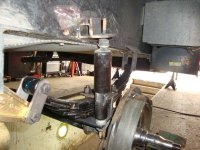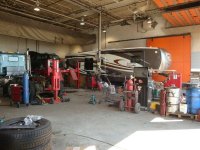brianharrison
Well-known member
I have wanted to make some improvements to my suspension for awhile now. My reasons were mostly preventative and for my piece of mind; I am not a happy camper when I break down on the road! So from what I learned here from others and their experiences AND to reduce the chance of that road failure, I did some preventative maintenance and made some improvements on my coach.
As well, for me, by my taking everything apart, inspecting and putting back together I am more comfortable and can detect any early signs of something going south.....
My trailer is in its 3rd season, pulled about 2000 miles per season. It is an early 2011 Landmark Grand Canyon model (manufacture date of April 2010, 16,200 GVWR). It came with Lippert 7000# axles, TrailAir EquiFlex spring equalizers, 6 leaf springs, G rated Goodyears. I started to see early tire wear on the inside of the rears. I am level when pulling and within 300#s weight on each axle (measured). So ahead of my first alignment I did some work to the suspension.
So here is what I did
There was a TON of grease in the brakes. I think the seals were not doing their job, I have never added grease through the zerk fitting.
The shock lower shafts were bent on 3 shocks - I just straightened and reused.
The oil on one of the hub face - came from the grease as the oil separates and makes its way out of the dust cap - the result is the grease in the bearing gets thicker!
The old brass bushings were not too bad, however I found one spring with NO bushing in the front eyelet.
Hope this is informative to other thinking about their suspensions...
Brian
As well, for me, by my taking everything apart, inspecting and putting back together I am more comfortable and can detect any early signs of something going south.....
My trailer is in its 3rd season, pulled about 2000 miles per season. It is an early 2011 Landmark Grand Canyon model (manufacture date of April 2010, 16,200 GVWR). It came with Lippert 7000# axles, TrailAir EquiFlex spring equalizers, 6 leaf springs, G rated Goodyears. I started to see early tire wear on the inside of the rears. I am level when pulling and within 300#s weight on each axle (measured). So ahead of my first alignment I did some work to the suspension.
So here is what I did
- replaced springs with a custom 7 leaf (estimate 3700-3900# rating), the extra leaf added was in the middle, about a 500# increase according to the spring tech),
- added NeverFail bushings,
- added a spacer plate between the axle and spring to mount the shock lower (OEM has shock mounted on the top plate) Note this requires a longer spring tab to extend through new plate into axle mount,
- replaced top shock mount with new one to accomodate new shock angle and mounting point (to put shock at 50% range of travel, static),
- new longer ubolts,
- replaced out TrailAir EquiFlex with Dexter EX-Flex - my equiflex was bending sideways, I think due to tire twisting at 70 degree jack knife into driveway. The Dexter is cast.
- repacked bearings with new seals (found one bearing pitted so replaced one bearing and race), replaced all dust caps with new ones.
- alignment with cold bending. Rear was out on toe and camber, front on camber.
There was a TON of grease in the brakes. I think the seals were not doing their job, I have never added grease through the zerk fitting.
The shock lower shafts were bent on 3 shocks - I just straightened and reused.
The oil on one of the hub face - came from the grease as the oil separates and makes its way out of the dust cap - the result is the grease in the bearing gets thicker!
The old brass bushings were not too bad, however I found one spring with NO bushing in the front eyelet.
Hope this is informative to other thinking about their suspensions...
Brian
Attachments
-
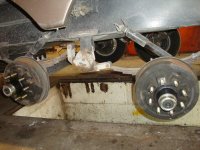 1 Original set up.jpg91.6 KB · Views: 161
1 Original set up.jpg91.6 KB · Views: 161 -
 2 Grease!.jpg85.2 KB · Views: 154
2 Grease!.jpg85.2 KB · Views: 154 -
 3 Bad Rear seal.jpg87.8 KB · Views: 150
3 Bad Rear seal.jpg87.8 KB · Views: 150 -
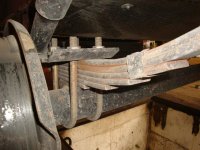 4 Old Spring shock arrangement.jpg77.6 KB · Views: 155
4 Old Spring shock arrangement.jpg77.6 KB · Views: 155 -
 5 Bent Shock.jpg82.5 KB · Views: 155
5 Bent Shock.jpg82.5 KB · Views: 155 -
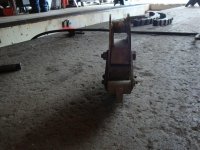 6 Bent equiflex.jpg90.5 KB · Views: 154
6 Bent equiflex.jpg90.5 KB · Views: 154 -
 8 New spring lower.jpg84.3 KB · Views: 154
8 New spring lower.jpg84.3 KB · Views: 154 -
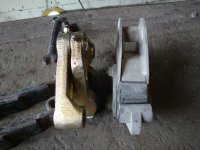 7 EXFlex on right.jpg88 KB · Views: 163
7 EXFlex on right.jpg88 KB · Views: 163 -
 9 New set up.jpg81 KB · Views: 157
9 New set up.jpg81 KB · Views: 157 -
 10 White line for toe Camber machine.jpg54.4 KB · Views: 149
10 White line for toe Camber machine.jpg54.4 KB · Views: 149 -
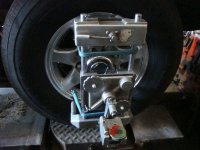 11 Camber measurement.jpg66.6 KB · Views: 157
11 Camber measurement.jpg66.6 KB · Views: 157 -
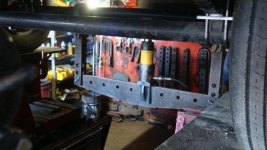 12 Cold bend setup with ram.jpg60.2 KB · Views: 156
12 Cold bend setup with ram.jpg60.2 KB · Views: 156 -
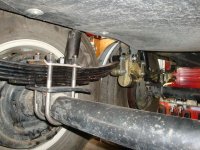 13 new spring details.jpg104.6 KB · Views: 151
13 new spring details.jpg104.6 KB · Views: 151

